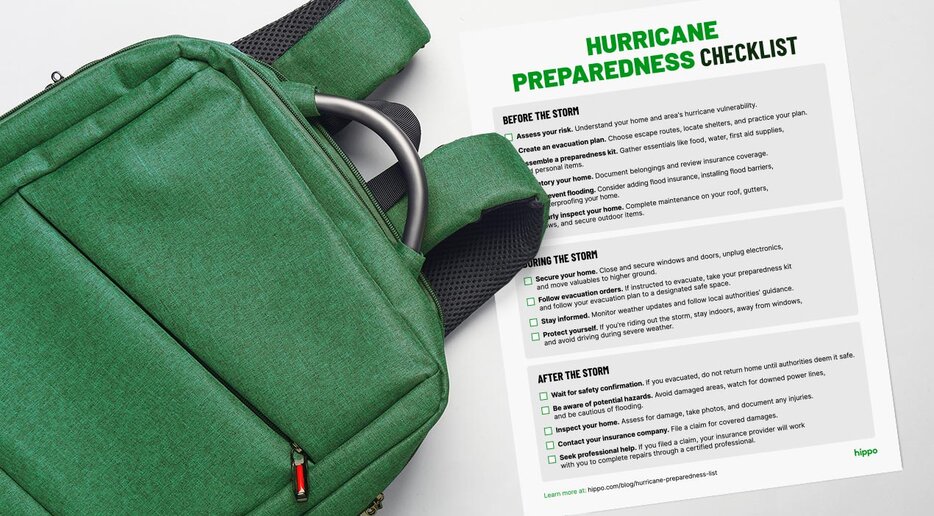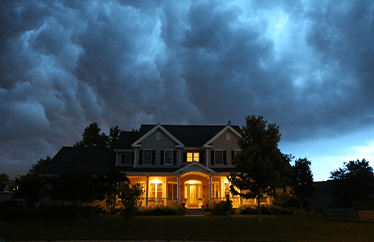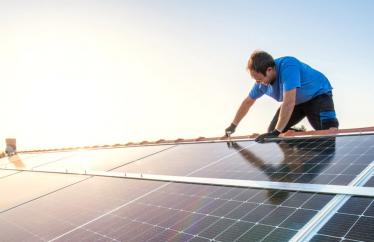Hurricane Preparedness Checklist

From June through November, the Eastern Seaboard and Central Pacific coasts of the United States brace themselves for hurricane season, with September and October being some of the most active months for hurricanes.
Over the past few decades, hurricane risks have escalated due to climate change and population growth in coastal areas. Studies cited by The New York Times reveal that between 2000 and 2023, Florida added more than 3 million people through domestic migration, while North and South Carolina added another 2.5 million. If you live in a hurricane-prone area, understanding the risks and preparing ahead of time can feel overwhelming—but it's essential to help limit potential damage.
Hurricanes are known to cause water damage, which according to our 2024 Housepower Report was a leading type of damage reported by surveyed homeowners. It’s also critical to consider the other ways a hurricane could impact your property. For example, infrastructure issues or extended power outages could make your home uninhabitable for an extended period of time.
Make sure you understand the risks for your area, what your homeowners insurance covers, and how to plan ahead when it comes to preparing your home for hurricane season.
1. Start with assessing your hurricane risk
Effort required: Low
Some states are at a significantly higher risk of seeing damages to real estate than others (we’re looking at you, Florida homeowners and Texas homeowners). However, all coastal states and cities along the Atlantic and the Gulf of Mexico could potentially be in the path of destructive winds.
Weather patterns can vary from year to year, so the time to prepare is now. Even if you didn’t experience a hurricane last season, you could be at risk this year. Additionally, if you recently moved into your home, you may be completely unfamiliar with Hurricane season and what that means for you.
Actions to take:
- Check your homeowners insurance policy type for hurricane-related coverage details. Confirm that your policy is up to date and that you know what’s covered. When completing this step, it’s also important to understand the out-of-pocket expenses tied to hurricane and wind deductibles, as these costs can vary.
- Use government resources. Websites like FloodSmart and Ready provide maps and data to identify potential hurricane hotspots. The Federal Emergency Management Agency (FEMA) is required to update flood maps every five years, so it's important to check them regularly. You could unknowingly live in a flood-prone area, so staying informed is crucial for preparedness.
- Explore the National Oceanic and Atmospheric Administration (NOAA) historical hurricane data to understand the frequency and intensity of hurricanes in your region.
- Consult with locals in your area. Talk to your neighbors, Homeowners Association (HOA), or even the previous homeowner to learn about the area's history and vulnerability to hurricanes.
2. Regularly inspect your home and property
Effort required: Medium
Doing a thorough inspection of your home can help prioritize and strategize which projects are most important when preparing for a hurricane. It can also help you decide which tasks you can complete and which need to be handled by a professional.
Actions to take:
- Roofs are exposed to weather all throughout the year, so remember to inspect and make repairs regularly, especially ahead of hurricane season. If you're uncomfortable assessing your roof, you can enlist the help of a roofing professional.
- Clearing out the debris from gutters is crucial to help prevent water damage that can occur from hurricanes. When gutters are clogged with debris, rainwater can't flow freely, leading to water buildup. This excess water can cause damage to your roof, foundation, and siding.
- Windows and doors, especially garage doors, are common weak points during storms and should be fortified to help protect your home. Opening treatments like reinforced doors or retractable window shutters could help deter hurricane damage.
- Store or cover outdoor items like patio furniture or barbecue grills. These items can be damaged or even picked up during a large hurricane. Make a plan if you normally keep them out in the open during the spring and summer seasons.
- Consider preparing your vehicle by moving it to higher ground or parking it in a garage or under a covered structure to protect it from strong winds, rain, and flying debris. Homeowners insurance policies may have specifications for securing cars and other property in case of storms or floods. Safeguarding these items in accordance with your policy will help ensure they are covered.
3. Inventory your home before hurricanes strike
Effort required: High
Creating an up-to-date home inventory can help ensure you have the right amount of homeowners insurance to protect your belongings. It can also help if you need to file a claim. Trying to recall every single thing you had in your home right after something as serious as a hurricane can be overwhelming, but if you take the time now, it could be a huge relief in the long run.
Actions to take:
- Walk through your home, documenting all belongings and their approximate value. Take photos of each item, especially valuables, and organize them into categories like electronics, furniture, clothing, and jewelry.
- Ensure your homeowners insurance adequately covers the value of your belongings. If necessary, increase coverage limits to reflect the current value of your possessions. Keep detailed records of high-value items.
- Secure important documents by storing originals in a safe deposit box and keeping copies at home. Consider scanning documents for electronic storage so you can access documents from anywhere.
- Use a home inventory app to help create a digital record of your belongings, track their location and value, and access your inventory from anywhere.
- Review and update your inventory annually or whenever significant changes occur. Add new items and remove old ones to ensure accuracy.
4. Prepare an evacuation plan
Effort required: Medium
Once you’ve established the risk level for your home and geographical area, the next item on your hurricane preparedness list should be creating an evacuation plan. Make sure to rehearse different scenarios, like what to do if loved ones are outside the home or if it’s the middle of the night. Then, sit back to evaluate together. Readjust your plan to fit the household's needs and different scenarios until everyone feels confident.
Actions to take:
- Choose at least two safe routes to escape your area in case of road closures or traffic congestion.
- Research typical traffic patterns during emergencies to help you plan your route. Make sure you’re prepared for potential detours or road closures.
- Find out the locations of public shelters in your area. Also, consider researching the rules and regulations of shelters, like pet policies or capacity limits.
- Many local governments in vulnerable areas will provide recommended evacuation routes. Get acquainted with these routes, drive them well before any storm watch or warning is in place, and make sure you have established a safe destination to wait out the storm.
- Select a meeting place outside of your evacuation zone where you can reunite with family and friends if separated.
- Practice your evacuation plan regularly to ensure everyone knows what to do in case of severe weather. This will also help identify any issues with the plan in advance.
5. Assemble a hurricane preparedness kit
Effort required: Medium
Having a thoroughly stocked hurricane preparedness kit is essential for those homes in hurricane-prone areas. Remember to check your supplies annually to ensure everything is up to date and in working order. Many home improvement and box stores will quickly run out of supply at the earliest hint of a hurricane—stock up before the season strikes.

- Include necessities like food, water, first aid supplies, a flashlight, a battery-powered radio, and a battery-powered charger. Also, consider emergency items such as a whistle, a can opener, and a map of the area.
- Don't forget to pack essential personal items like medications, eyeglasses, and important documents like birth certificates, social security cards, health insurance information, or your insurance documents.
- Regularly maintain your kit by inspecting it periodically to ensure items are usable, replace expired or damaged items, and practice using the supplies to familiarize yourself with their operation.
6. Know what to do after a hurricane
- Work with local law enforcement to confirm it’s safe to return home. When you return home, first look around and note any areas that appear structurally unsound, water-damaged spots producing mold or roof areas that appear soft or sagging.
- Following a severe hurricane, FEMA or local chapters of the National Guard may set up hotlines for reporting structurally dangerous homes and buildings. Call the hotline if necessary then call your insurance company to file your claim.
- If you suspect a gas leak at any point, leave your house immediately, keep a safe distance, and call your utility company.
- If you feel that any area of your home poses an imminent danger to you or your family, immediately exit the residence and contact safety authorities.
7. Consider how you can flood-proof your home
- Install flood barriers using sandbags, permanent barriers, or flood shutters to help protect your home from water damage.
- Waterproof your basement by sealing any cracks or openings in the walls and applying waterproofing paint or sealant. You could also install a sump pump to help remove any accumulated water or even consider water backup coverage for extended insurance protection.
- If you have time before evacuating, help protect your electrical systems by disconnecting power to your home and unplugging your appliances. If you need to stay in your home during the storm, use battery-powered devices and avoid using generators indoors.
- Consider landscaping as a potential solution. Plant flood-resistant greenery, create rain gardens, and minimize impervious surfaces to help manage rainwater and reduce flood risk.
- Help protect your property with flood insurance. Flood insurance is not typically included in standard homeowner's policies, but it can offer valuable financial protection. Learn more about what flood insurance covers to help prepare for potential flooding.

Table of Contents:
Related Articles

Can Your Homeowners Insurance Weather Hurricane Season?

Severe Weather Prep Report: How Homeowners Are Bracing for Costs

Young Homeowners Fear Natural Disasters Most, Despite Preparation

What Homebuyers Need To Know About Climate Change and Their Home

Building a Home For Your Climate + Best Climate-Resistant Materials

